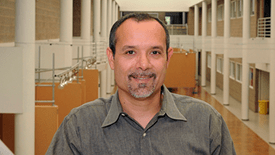Creating a better park: UNC Charlotte, University City Partners, county seek innovative ideas

University City Partners, UNC Charlotte and Mecklenburg’s parks department have launched a partnership that may lead to innovative new parks both here and across the county. Graduate urban design students also will benefit as they take on the challenge of adding recreational space to an already living, vibrant community, said José Gámez, associate professor of architecture and urban design.
“I don’t know of any (university) project that has had that connection to a real-world client at this moment, in the way that University City Partners can influence what things get built someday,” Gámez, coordinator of the Architecture School’s City.Building.Lab, stated.
Parks Director Jim Garges also has high praise for the project. “The thing that I like about it, and we’re really excited about it, is that we’ve got this opportunity to continue to work with UNC Charlotte students and professors, and it’s a unique opportunity.”
Gámez said the project grew out of separate requests from Mecklenburg County Park and Recreation and University City Partners.
The parks department has begun an update of the countywide 2008 parks master plan. Garges said the department wanted UNC Charlotte’s help devising a method to show the benefits of park and rec activities both to individuals and the community.
“Things that we intuitively know: Gee, it improves our quality and life, and you do surveys and people say, ‘Yes, it does.’” Garges explained. “But what kind of metric can you develop to provide data that supports the intuitive?”
University City Partners, meanwhile, was monitoring the update of transit station plans for the LYNX Blue Line Extension. Many people attending public presentations talked about the need for mini-parks around the stations and something like a Central Park for community gatherings.
UCP’s executive director, Darlene Heater, asked the University for help in showing how to incorporate mini-parks along heavily developed North Tryon Street. UCP also wanted to identify other park opportunities in the municipal service district that hopefully could be included in the county’s new parks master plan.
“As we worked with the City and County on the University City Area Plan update, we immediately recognized the need and window of opportunity to make bigger moves for parks in University City,” Heater said. “We are excited to have great partners who are willing to put their shoulders to the task. The product of this planning effort will be a tool (strategy) that informs our decisions on types of parks, amount of park space, programming and connectivity.”
The final project that begins this week combines those overlapping goals, adds a strong research component and harnesses the talents of three successive classes of urban-design graduate students, their professors and other local professionals.
Each spring semester through 2017, graduate urban-design students enrolled in the School of Architecture’s Master of Urban Design Program will use University City’s business district and coming light-rail line to address a real-world problem, Gámez said. Working with professors and professional planners and architects, the teams will gather data, look at problems such as creating open space along a crowded commercial strip and consider how they can manage environmental issues such as urban runoff into nearby streams.
Garges expects some of the research to also look at parks from a holistic standpoint – “not just what we do with one neighborhood park, but how it ties in with the whole area, because connectivity becomes very important.”
Teams will then refine and present their solutions to a panel of experts. Student teams in years two and three will build upon the work of the previous teams, Gámez says.
Helping guide the project are Richard Petersheim, a partner and senior landscape architect at LandDesign, and Ming-Chun Lee, assistant professor of architecture and urban design at UNC Charlotte. Petersheim directs an urban-design studio at LandDesign with focus on strategic urban planning, infill development, transit planning and station area design, and high-end retail planning.
Lee teaches community planning and urban design, with a special emphasis on the use of digital technologies in urban design and planning processes.
The students will take part in several studio meetings each spring led by various experts from LandDesign, each with specific areas of expertise ranging from master planning to specific site design.
Both Park and Rec and University City Partners will benefit from the ideas presented by UNC Charlotte students, Gámez says. The students’ research and presentations, while focused on specific University City projects, “are, in principal, ideas that we might be able to extrapolate to Mecklenburg County generally,” he says. “We start building an archive and database that might allow us to develop a countywide set of proposals.”
Urban-design students will also benefit as they explore new models in open-space design while working with both for-profit and not-for-profit clients. “It’s one thing to design a park in a greenfield (undeveloped open space). It’s another thing to work in an existing landscape. It’s a really complex design challenge to have a living, vibrant community to look at and add even more dynamism to it,” Gámez says.
Heater expects the project to benefit greatly from the students’ wealth of fresh ideas and enthusiasm. “This is an out-of-the-box approach to addressing a city-building need. Imagine pairing these young professionals’ passion, creativity and enthusiasm for new ideas with the experience and expertise of LandDesign and Mecklenburg County Park and Recreation. This is an extraordinary opportunity for these future planners and architects.”
This article was originally published by University City Partners